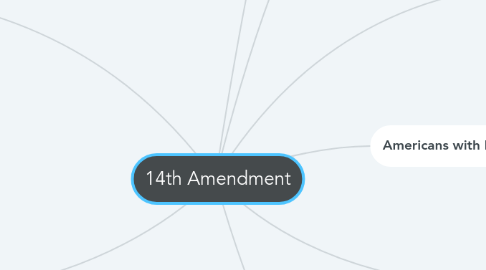14th Amendment
by R Ochoa


1. Equal pay
1.1. “No employer . . . shall discriminate . . . between employees on the basis of sex by paying wages to employees in such establishment at a rate less than the rate at which he pays employees of the opposite sex in such establishment for equal work. . .”
1.2. Made sure that all the people excluding race, religion, gender, handicap, or national origin would have an opportunity like others to be employed.
1.3. Men and woman should receive equal pay for equal work
2. Civil Rights Act
2.1. Guaranteed equal voting rights to all citizens
2.2. Segregation in public schools was not allowed and any type of discrimination was not allowed
2.3. It was established to enforce parts of the law
2.4. EEOC was th Equal Emplyment Opertunity Comission
2.5. Investigates complains about hiring someone or firing them
3. Black codes
3.1. It was passed in 1865 and 1866
3.2. They were similar in attempts to limit African American 's freedom
3.3. Some black codes made it illegal for blacks to be unemployed, to go to public school, or to marry any other people of their race.
3.4. They were a group of laws passed in the confederate states after the Civil War
4. Fourteenth Amendment
4.1. "All persons born or naturalized in the United States, and subject to the jurisdiction thereof, are citizens of the United States and of the State wherein they reside. No State shall make or enforce any law which shall abridge the privileges or immunities of citizens of the United States; nor shall any State deprive any person of life, liberty, or property, without due process of law; nor deny to any person within its jurisdiction the equal protection of the laws"
4.1.1. It guarantees equal lrotection under the law to all Americans
4.1.2. It aimed to extend more protections to blacks by granting citizenship
4.1.3. Provides some preocedures for reintegrating southern voters
4.1.4. It prevents the states and federal government from creating Legal forms against discrimination
5. Brown vs Board of Education
5.1. "Segregation of . . . children in the public schools of a State solely on the basis of race . . . denies to [African American] children the equal protection of the laws guaranteed by the Fourteenth Amendment—even though the physical facilities and other ‘tangible’ factors of white and [African American] schools may be equal. . . . The ‘separate but equal’ doctrine adopted in Plessy v. Ferguson . . . has no place in the field of public education"
5.1.1. Thurgood Marshall, NAACP, was the lawyer who argued the case
5.1.2. It took 2 years to enforce st state level
5.1.3. Supreme Court ruled hat segregation in public schools was unconstitutional

